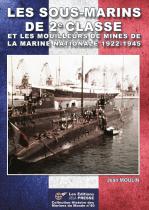Since 1912, aircraft carriers have been in service in the French Navy.
The seaplane carriers of the First World War were followed in 1928 by a first aircraft carrier, the Béarn. Expired, it is not engaged in combat during the Second World War but the personnel it trained allows in 1945 the reconstitution of an on-board avation which will have two aircraft carriers of British origin, the Dixmude and the 'Arromanches and then two former Americans, La Fayette and Bois Belleau, widely involved in Indochina.
The Clemenceau and the Foch, of national construction, served between 1960 and 2000 with
homogeneous air groups and intervene in many troubled areas.
A new generation appeared in 2000 with the Charles de Gaulle and the Rafale.
The whole is written on 336 pages, with approximately 640 photos and 90 diagrams and color profiles.
We talk about it in the Press and on the Net:
Planes and boats = Aero - Naval, a duo which made and still makes sparks since the very beginning of military aviation and which by dint of demonstrations and experiments knew how to impose itself with more or less success with old admirals supporters of the battle in line with battleships and battle cruisers which have become totally obsolete with the arrival of the flat bridges and this from the outbreak of the second world war ... A sacred change of strategy and orientation which worked wonders on all the seas of the globe ... then dominated by England and the USA ...
And France in all this, it made up the figuration with what it had on hand, that is to say not much while it was one of the pioneering nations in the matter with the Lightning then the Béarn followed by a few other so-called second-hand units and this long before the invention of Bon Coin! .... Well, naval aviation had some problems with on-board aircraft not always developed and also with the mode of strategic use of this type of ship, but let's face it, the "young" officers of the time were able to find and quickly develop effective operational modes, some of which are still used today, that's for the general context ...
Jean Moulin, takes back from him all the stories of the units that were used by the French Navy from the start and the list is in itself long enough to make it a so-called "reference" work with nuggets in documentary matter and with the history of each ship, ship scrutinized with a total mastery of a subject rarely treated from this angle ... Photos in quantity, plans galore and a beautiful tribute to our aero-marines, all not limited to not to simple PAs but also to helicopter carriers and support vessels with the added bonus of all the devices on board ... As a job, it's great art and it is to be underlined because our aircraft carriers have finally found there a place of choice in the library on board ... © Marc Debeer - Fleuves & Canaux.
- At a time when Aerobuzz and its readers are wondering about the name of the future replacement for Charles de Gaulle, the latest work by Jean Moulin, "All the aircraft carriers in France" is timely to remind us of the rich hours of the French on-board aviation.
In its collection Navire & Histoire des marines du monde, the Lela Presse editions therefore publish under the signature of Jean Moulin, who is no longer at his first attempt, a very interesting summary of all the French ships that have worn, or continuing to carry, aircraft. We are talking about aircraft carriers of course, but not only: helicopter carriers and amphibious helicopter carriers are meticulously reviewed.
A few pages, too few for our taste, are even devoted to all the ships carrying seaplanes (the day before yesterday) and helicopters (yesterday and today).
The history and technique of boarding helicopters is a rich subject that deserves a book on its own, but the author already has a large amount of information to fit into the 340 pages allocated, we will not hold it against him to pass a little quickly on the subject.
The book as it stands therefore brings together a considerable mass of historical and technical information, very well illustrated. The book is dense but reads very well: a good buy for anyone interested in the fruitful marriage of aviation and navy under the French colors! © Frédéric Lert.
- A work at the crossroads between aeronautics and navy. The author tells us on 330 pages the history of the various French aircraft carriers: first works during WW1, Béarn, Commandant Teste, studies during the 1930s and during WWII (Le Joffre, 1er Clémenceau ), Le Dixmude, L'Arromanches, les Lafayette / Bois Belleau, Les Clémenceau / Foch, Charles de Gaulle, Joan of Arc, TCD, Mistral types.
Iconography:
338 photos of ships
200 photos of planes and helicopters
· 70 ship profiles (without coloring) + various detailed sketches, particularly for the evolution of flight decks and massifs.
An individual chapter is devoted to each ship detailing its career (including any careers under a foreign flag) and describing its technical characteristics with all their evolutions (hence the sketches showing the evolution, in particular of the massifs and their various antennas. and armaments).
An important point to note: the author has treated in as much detail as he could find in the archives the many aircraft carrier projects that have emerged (the projects have emerged but the ships have never seen the sea).
Model makers will appreciate that the “paint and camouflage” aspects are dealt with in the technical description section, there is even an appendix devoted to hull brands.
On the aeronautical side, around forty pages are dedicated to airplanes and helicopters and in the body of the text all aeronautical events (from the “1st landing” to the various accidents that can happen: all the pilots and passengers who died in combat or by accident are identified!)
Note a very useful and infrequent appendix: the list of abbreviations, acronyms and acronyms mentioned: a very good idea, all the more so in a book which brings together two worlds: naval and aeronautical, each with its own language and codes. .
Conclusion: an excellent book which manages to concentrate in a number of pages which is ultimately "quite small" (over 300 pages anyway!), Everything there is to know on the subject covered! In short, what one of my fellow columnists would call a "crush" © Modelstories 2021








